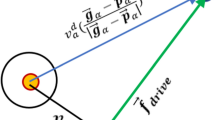Abstract
Crowd simulation has been becoming an efficient tool to study the crowd behaviour and its movement. Compared with macroscopic model, microscopic model is able to generate a fine grain simulation result. This paper proposes a agent-based model for crowd simulation for dense area. The simulation model considers how agent selects a goal as its moving destination, how avoids collision with neighboured agents, how leads or follow a group of agents, and how avoids high dense area to reduce its traveling time. Simulation results show the proposed agent-based model is able to simulate agent navigating and move around dense simulation environment. The simulation performance is also efficient.
This study was supported in part by National Natural Science Foundation of China (grant No.61103145), and the Fundamental Research Funds for the Central Universities, (China University of Geosciences (Wuhan), No.CUG100314 and No.CUG120409).
Access this chapter
Tax calculation will be finalised at checkout
Purchases are for personal use only
Preview
Unable to display preview. Download preview PDF.
Similar content being viewed by others
References
Dynamics, C.: Crowd disaster (June 2008), http://www.crowddynamics.com/main/crowddisasters.html
Thalmann, D., Musse, S.R.: Crowd Simulation. Springer (2007)
Daly, P., McGrath, F., Annesley, T.: Pedestrian speed/flow relationships for underground stations. Traffic Engineering and Control 32(2), 75–78
Bradley, G.E.: A proposed mathematical model for computer prediction of crowd movements and their associated risks. In: Smith, R.A., Dickie, J.F. (eds.) Proceedings of the International Conference on Engineering for Crowd Safety, pp. 303–311. Elsevier Publishing Company, London (1993)
Tanaka, T.: A study for performance based design of means of escape in fire. In: Cox, G., Langford, B. (eds.) Proceedings of the 3rd International Symposium on Fire Safety Science, pp. 729–738. Elsevier (1991)
Burstedde, C., Klauck, K., Schadschneider, A., Zittartz, J.: Simulation of pedestrian dynamics using a two-dimensional cellular automaton. Physica A: Statistical Mechanics and its Applications 295(3-4), 507–525 (2001)
Muramatsu, M., Irie, T., Nagatani, T.: Jamming transition in pedestrian counter flow. Physica A: Statistical Mechanics and its Applications 267(3-4), 487–498 (1999)
Nguyen, Q.H., McKenzie, F.D., Petty, M.D.: Crowd behavior cognitive model architecture design. In: Proceedings of the 2005 Behavior Representation in Modeling and Simulation (BRIMS) Conference, Universal City, CA, pp. 55–64 (2005)
Pelechano, N., O’Brien, K., Silverman, B., Badler, N.: Crowd simulation incorporating agent psychological models, roles and communication. In: Proceedings of the First International Workshop on Crowd Simulation, EPFL, Lausanne-Switzerland (November 2005)
Brogan, D., Hodgins, J.: Group behaviors for systems with significant dynamics. Autonomous Robots 4(1), 137–153 (1997)
Helbing, D., Farkas, I., Vicsek, T.: Simulating dynamical features of escape panic. Letters to Nature 407, 487–490 (2000)
Chenney, S.: Flow tiles. In: Proceedings of the 2004 ACM SIGGRAPH/ Eurographics Symposium on Computer Animation, San Diego, California, USA, July 26-27, pp. 233–242 (2004)
Greenshields, B.D.: A study in highway capacity. Highway Research Board Proceedings 14, 448–478 (1934)
Smith, R.A.: Volume flow rate of densely packed crowds. In: Smith, R.A., Dickie, J.F. (eds.) Proceedings of the International Conference on Engineering for Crowd Safety, pp. 313–319. Elsevier Publishing Company, London (1993)
Smith, R.A.: Density, velocity and flow relationships for closely packed crowds. Safety Science 18(4), 321–327 (1995)
Pearl, J.: Probabilistic Reasoning in Intelligent Systems: Networks of Plausible Inference. Morgan Kaufman, San Mateo (1998)
Zadeh, L.A.: Fuzzy logic. IEEE Computer 22(4), 83–93 (1998)
Hassoun, M.H.: Fundamentals of Artificial Neural Networks. MIT Press (1995)
Rao, A.S., Georgeff, M.P.: An abstract architecture for rational agents. In: Proceedings of Knowledge Representation and Reasoning, pp. 439–449 (1992)
Yu, Q., Terzopoulos, D.: A decision network framework for the behavioral animation of virtual humans. In: Proceedings of Eurographics/ACM SIGGRAPH Symposium on Computer Animation 2007, San Diego, USA, pp. 119–128 (August 2007)
Rymill, S.J., Dodgson, N.A.: A psychologically-based simulation of human behaviour. In: Proceedings of Theory and Practice of Computer Graphics 2005, pp. 35–42 (2005)
Fridman, N., Kaminka, G.A.: Towards a cognitive model of crowd behavior based on social comparison theory. In: Proceedings of the Twenty-Second AAAI Conference on Artificial Intelligence, Vancouver, British Columbia, Canada, pp. 731–737 (July 2007)
Wolfram, S.: Theory and applications of Cellular Automata. World Press (1986)
Kirchner, A., Schadschneider, A.: Simulation of evacuation processes using a bionics-inspired cellular automaton model for pedestrian dynamics. Physica A: Statistical Mechanics and its Applications 312(1-2), 260–276 (2002)
Henein, C.M., White, T.: Macroscopic effects of microscopic forces between agents in crowd models. Physica A: Statistical Mechanics and its Applications 373, 694–712 (2007)
Festinger, L.: A theory of social comparison processes. Human Relations, 117–140 (1954)
Pushkarev, B., Zupan, J.M.: Capacity of walkways. Transportation Research Record (538), 1–15 (1975)
Author information
Authors and Affiliations
Editor information
Editors and Affiliations
Rights and permissions
Copyright information
© 2012 Springer-Verlag Berlin Heidelberg
About this paper
Cite this paper
Xiong, M., Chen, Y., Wang, H., Hu, M. (2012). An Agent-Based Model for Simulating Human-Like Crowd in Dense Places. In: Li, Z., Li, X., Liu, Y., Cai, Z. (eds) Computational Intelligence and Intelligent Systems. ISICA 2012. Communications in Computer and Information Science, vol 316. Springer, Berlin, Heidelberg. https://doi.org/10.1007/978-3-642-34289-9_2
Download citation
DOI: https://doi.org/10.1007/978-3-642-34289-9_2
Publisher Name: Springer, Berlin, Heidelberg
Print ISBN: 978-3-642-34288-2
Online ISBN: 978-3-642-34289-9
eBook Packages: Computer ScienceComputer Science (R0)




